
|
It approached to the sun down to 0.12 A.U. on July 14. Now, it is appearing in the evening sky in the Northern Hemisphere. Now it is very bright as 7.8 mag (July 22, Juan Jose Gonzalez). It keeps observable while fading rapidly in the evening low sky after this. In the Southern Hemisphere, it will be observable in good condition again in the evening sky after August.
Date(TT) R.A. (2000) Decl. Delta r Elong. m1 Best Time(A, h)
July 28 10 33.09 29 14.3 0.907 0.505 29 8.9 20:44 (118, 10)
Aug. 4 11 53.56 23 13.6 0.902 0.689 41 10.5 20:35 (105, 19)
|

|
Now it is so bright as 11.0 mag (July 20, Marco Goiato). It is expected to be bright as 9 mag from 2012 to 2013. In the Northern Hemisphere, it keeps observable in good condition for a long time until 2012 autumn when the comet brightens up to 10 mag. In the Southern Hemisphere, it is hardly observble before the perihelion passage. But it becomes observable in good condition since 2013 after the perihelion passage.
Date(TT) R.A. (2000) Decl. Delta r Elong. m1 Best Time(A, h)
July 28 14 8.69 33 39.2 2.782 2.709 75 11.0 20:44 (101, 53)
Aug. 4 14 12.68 30 42.3 2.782 2.650 71 10.9 20:35 ( 98, 49)
|
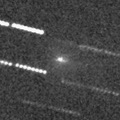
|
Brightening rapidly. It is very bright as 10.4 mag visually (July 23, Juan Jose Gonzalez). It has a large coma. It is expected to reach up to 10 mag in August. It keeps observable in the morning sky all through this apparition, although it locates somewhat low.
Date(TT) R.A. (2000) Decl. Delta r Elong. m1 Best Time(A, h)
July 28 4 37.95 26 29.5 1.113 0.964 53 11.7 3:27 (257, 29)
Aug. 4 5 17.11 25 23.9 1.137 0.943 51 11.3 3:35 (257, 28)
|

|
It kept as bright as 6-7 mag for a long time from 2011 summer to 2012 spring. Now it is not observable. It will appear in the morning sky again at 12.5 mag in October.
Date(TT) R.A. (2000) Decl. Delta r Elong. m1 Best Time(A, h)
July 28 9 30.31 13 24.5 4.125 3.158 15 11.5 20:44 (116,-12)
Aug. 4 9 34.61 12 8.1 4.219 3.226 10 11.7 20:35 (117,-15)
|

|
Now it is so bright as 11.3 mag (July 21, Marco Goiato). It is expected to be observable at 11-13 mag for a long time from 2012 summer to 2013 summer. It will be observable in excellent condition in the Southern Hemisphere. But it is not observable until 2013 January in the Northern Hemisphere.
Date(TT) R.A. (2000) Decl. Delta r Elong. m1 Best Time(A, h)
July 28 5 57.49 -66 34.0 2.064 2.303 90 11.7 3:27 (332,-32)
Aug. 4 6 56.84 -69 40.3 2.039 2.269 89 11.6 3:35 (335,-35)
|

|
It is expected to be a great comet of -1 mag in 2013 spring. Now it is 11.9 mag (July 17, Carlos Labordena). Brightening faster than originally expected. In 2012, it keeps observable until summer while brightening gradually. It locates somewhat low in the Northern Hemisphere.
Date(TT) R.A. (2000) Decl. Delta r Elong. m1 Best Time(A, h)
July 28 15 7.37 -24 58.4 3.386 3.794 106 12.4 20:44 ( 30, 23)
Aug. 4 15 3.92 -24 56.3 3.419 3.710 98 12.4 20:35 ( 35, 21)
|
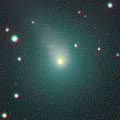
|
It brightened much faster than expected. Now it is so bright as 10.7 mag (July 16, Juan Jose Gonzalez). In the Northern Hemisphere, it keeps observable at 11-13 mag in good condition until early 2013. Although it becomes extremely low in August, it will be getting higher again in the morning sky after September. In the Southern Hemisphere, it is not observable until late 2012.
Date(TT) R.A. (2000) Decl. Delta r Elong. m1 Best Time(A, h)
July 28 9 25.53 55 41.5 2.843 2.139 38 12.7 20:44 (148, 16)
Aug. 4 9 32.57 52 58.1 2.874 2.144 36 12.8 20:35 (147, 12)
|

|
Big asteroid discovered in 1906. It suddenly showed the cometary activity on Dec. 11, 2010, probably due to an impact of a small object. Now it is 11.9 mag (May 29, Marco Goiato). It has already turned to be stellar.
Date(TT) R.A. (2000) Decl. Delta r Elong. m1 Best Time(A, h)
July 28 16 4.88 -26 5.6 1.807 2.465 118 13.2 20:44 ( 16, 27)
Aug. 4 16 7.78 -26 37.3 1.888 2.469 113 13.3 20:35 ( 20, 25)
|

|
Now it is bright as 12.8 mag (June 15, Sandor Szabo). It keeps bright as 13-14 mag for a long time after this until 2013. It is not observable in the Northern Hemisphere, but it is observable in good condition in the Southern Hemisphere.
Date(TT) R.A. (2000) Decl. Delta r Elong. m1 Best Time(A, h)
July 28 4 53.78 -52 41.5 5.655 5.667 85 13.7 3:27 (321,-19)
Aug. 4 4 56.71 -52 57.5 5.641 5.681 87 13.7 3:35 (325,-16)
|

|
Now it is so bright as 11.4 mag (July 16, Juan Jose Gonzalez). It keeps 12-14 mag and observable in good condition until September.
Date(TT) R.A. (2000) Decl. Delta r Elong. m1 Best Time(A, h)
July 28 15 35.98 -12 7.2 4.765 5.190 109 13.8 20:44 ( 30, 38)
Aug. 4 15 30.90 -12 11.8 4.900 5.198 101 13.8 20:35 ( 36, 35)
|
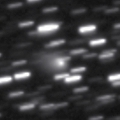
|
Now it is 13.2 mag (July 16, Juan Jose Gonzalez). It is expected to be 13 mag and will be observable in good condition in 2013. It keeps observable for a long time in the Northern Hemisphere. It is not observable in the Southern Hemisphere.
Date(TT) R.A. (2000) Decl. Delta r Elong. m1 Best Time(A, h)
July 28 22 36.23 57 18.1 6.014 6.259 99 13.8 2:14 (180, 68)
Aug. 4 22 25.46 57 18.1 5.932 6.243 103 13.8 1:35 (180, 68)
|

|
Now it is 13.3 mag (July 11, Jakub Cerny). It still locates high and will be observable until early September in the Southern Hemisphere. It will be unobservable soon in the Northern Hemisphere.
Date(TT) R.A. (2000) Decl. Delta r Elong. m1 Best Time(A, h)
July 28 12 19.88 -10 52.9 6.630 6.253 64 14.1 20:44 ( 71, 8)
Aug. 4 12 23.38 -11 9.7 6.725 6.252 58 14.1 20:35 ( 73, 4)
|

|
This comet brightened up to 10 mag in outburst in 1995, however, it became lost after that. The condition of this apparition is bad. It was not observable around the perihelion passage. But it is appearing in the morning sky now.
Date(TT) R.A. (2000) Decl. Delta r Elong. m1 Best Time(A, h)
July 28 5 58.50 13 44.3 2.566 1.853 36 14.1 3:27 (258, 6)
Aug. 4 6 14.03 13 28.6 2.574 1.903 39 14.3 3:35 (261, 10)
|
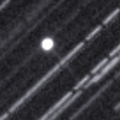
|
Looks almost asteroidal. But it has a very faint tail. Bright as 13.9 mag (July 22, Artyom Novichonok). It keeps 14.5-15 mag until mid August. It moves northwards rapidly and keeps observable in excellent condition in the Northern Hemisphere. In the Southern Hemisphere, it will be extremely low after August.
Date(TT) R.A. (2000) Decl. Delta r Elong. m1 Best Time(A, h)
July 28 21 57.51 33 59.2 0.598 1.433 123 14.1 1:37 ( 0, 89)
Aug. 4 20 52.89 40 47.5 0.662 1.476 121 14.4 0:06 (180, 84)
|
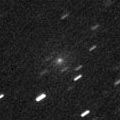
|
Now it is 16.6 mag (July 19, Hidetaka Sato). It was expected to brighten up to 13.5 mag from summer to autumn. But actually, it is much fainter than expected. Sato reported the nuclear magnitude is fainter than 19 mag. Maybe the comet has been disintegrated, and will disappear soon. It keeps observable for a long time until December, but it keeps locating low in the evening after this.
Date(TT) R.A. (2000) Decl. Delta r Elong. m1 Best Time(A, h)
July 28 12 29.43 21 35.6 1.921 1.591 55 14.4 20:44 ( 97, 28)
Aug. 4 12 45.66 19 17.1 1.893 1.535 54 14.2 20:35 ( 96, 26)
|

|
First return of a new periodic comet which brightened up to 14 mag in 2005. It was reported so bright visually as 12.8 mag on July 23 (Juan Jose Gonzalez) and 11.6 mag on July 28 (Marco Goiato). It will brighten up to 12-13 mag from summer to autumn, and will be observable in excellent condition.
Date(TT) R.A. (2000) Decl. Delta r Elong. m1 Best Time(A, h)
July 28 1 5.65 -0 29.6 0.909 1.578 110 14.6 3:27 (330, 50)
Aug. 4 1 17.21 2 34.1 0.849 1.556 112 14.3 3:35 (337, 55)
|

|
Now it is so bright as 11.6 mag (June 14, Juan Jose Gonzalez). Although it was extremely faint as 20.5 mag at the recovery in 2010 autumn, it brightened rapidly. It will keep 12-14 mag and observable in good condition for a long time from 2012 to 2013. But it locates somewhat low in the Northern Hemisphere in 2013.
Date(TT) R.A. (2000) Decl. Delta r Elong. m1 Best Time(A, h)
July 28 13 17.36 3 13.5 3.204 3.043 71 14.4 20:44 ( 73, 28)
Aug. 4 13 23.82 1 58.2 3.278 3.031 67 14.4 20:35 ( 74, 24)
|

|
It kept as bright as 11-12 mag for a long time from 2011 autumn to 2012 spring. It is not observable now. But it will appear in the morning sky again at 15 mag in autumn.
Date(TT) R.A. (2000) Decl. Delta r Elong. m1 Best Time(A, h)
July 28 7 51.12 16 27.4 3.531 2.535 9 14.6 3:27 (239,-13)
Aug. 4 8 3.98 15 47.2 3.545 2.566 12 14.6 3:35 (243,-10)
|

|
Now it is 14.8 mag (July 11, Jakub Cerny). In the Southern Hemisphere, it will be observable at 15-16 mag in good condition for a long time until 2013 summer. It is not observable at all in the Northern Hemisphere.
Date(TT) R.A. (2000) Decl. Delta r Elong. m1 Best Time(A, h)
July 28 18 41.46 -81 34.3 3.336 3.895 116 15.0 22:14 ( 0,-27)
Aug. 4 18 4.28 -82 4.1 3.384 3.893 112 15.0 21:10 ( 0,-27)
|

|
Now it is 14.5 mag (July 19, P. C. Sherrod). It keeps observable in good condition at 14-15 mag for a long time until winter. It locates somewhat low in the Southern Hemisphere.
Date(TT) R.A. (2000) Decl. Delta r Elong. m1 Best Time(A, h)
July 28 23 48.34 37 46.9 2.974 3.405 106 15.2 3:25 (180, 87)
Aug. 4 23 50.29 38 31.2 2.881 3.381 111 15.1 3:00 (180, 86)
|

|
Now it is 15.8 mag (June 30, Jakub Cerny). After this, it will be observable in good condition in the Southern Hemisphere while fading gradually. It will locate somewhat low in the Northern Hemisphere. In 2011, some visual observers reported it was very bright as 10-12 mag.
Date(TT) R.A. (2000) Decl. Delta r Elong. m1 Best Time(A, h)
July 28 23 16.67 -22 17.4 2.527 3.377 140 15.4 2:54 ( 0, 33)
Aug. 4 23 14.86 -23 29.4 2.532 3.429 147 15.5 2:24 ( 0, 32)
|

|
Now it is 14.5 mag (July 17, Yasukazu Ikari). It is expected to approach to the earth and to be observable at 9-10 mag in good condition in winter. The condition is good in the Northern Hemisphere. It locates low in the Southern Hemisphere, and will be unobservable after summer. But it will become observable in good condition after 2013 January.
Date(TT) R.A. (2000) Decl. Delta r Elong. m1 Best Time(A, h)
July 28 16 31.54 48 21.7 1.841 2.168 94 15.7 20:44 (154, 75)
Aug. 4 16 9.64 48 15.5 1.850 2.089 88 15.5 20:35 (138, 70)
|
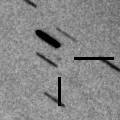
|
It was expected to brighten up to 14 mag from May to July. But actually, it has not been observed since late January. Michael Mattiazzo reported it was not detected, fainter than 17.0 mag, on June 10. In the Southern Hemisphere, it will be getting higher gradually after this. It will be hardly observable in the Northern Hemisphere.
Date(TT) R.A. (2000) Decl. Delta r Elong. m1 Best Time(A, h)
July 28 12 21.05 -16 54.1 1.414 1.384 67 15.7 20:44 ( 66, 5)
Aug. 4 12 39.38 -13 20.8 1.606 1.455 62 16.2 20:35 ( 69, 7)
|
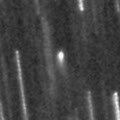
|
It has brightened rapidly, and it reached up to 15.0 mag (July 8, Katsumi Yoshimoto). Now it is approaching to the earth down to 0.17 A.U., and moving northwards very quickly. Now it is observable in excellent condition. It keeps observable in good condition after this in the Northern Hemisphere. In the Southern Hemisphere, it keeps excellent condition until July. It keeps observable also after that, but locates somewhat low.
Date(TT) R.A. (2000) Decl. Delta r Elong. m1 Best Time(A, h)
July 28 19 10.90 23 12.6 0.224 1.181 133 16.0 22:45 ( 0, 79)
Aug. 4 19 20.85 30 2.9 0.260 1.191 127 16.3 22:28 ( 0, 86)
|

|
The condition of this apparition is bad, and it was not observable around the perihelion passage. Now it is 15.7 mag (June 30, Jakub Cerny). It will be fading after this, and will be fainter than 18 mag in late October.
Date(TT) R.A. (2000) Decl. Delta r Elong. m1 Best Time(A, h)
July 28 2 3.33 3 11.8 2.192 2.499 95 16.3 3:27 (308, 46)
Aug. 4 2 6.84 3 21.1 2.141 2.538 100 16.4 3:35 (318, 51)
|

|
Now it is 17.0 mag (July 29, Hidetaka Sato). Brightening rapidly. It will approach to the earth down to 0.4 A.U., and it is expected to be observable in good condition as bright as 15 mag in September and October.
Date(TT) R.A. (2000) Decl. Delta r Elong. m1 Best Time(A, h)
July 28 0 33.10 -21 32.7 0.791 1.593 123 17.0 3:27 (348, 33)
Aug. 4 0 39.96 -19 15.9 0.720 1.560 127 16.7 3:35 (356, 36)
|

|
Now it is 17.2 mag (June 5, A. Diepvens). It will brighten up to 15 mag from autum to winter. In the Northern Hemisphere, it keeps observable for a long time until the comet fades out. It is not observable in the Southern Hemisphere, except for 2013 spring, but the comet locates extremely low only.
Date(TT) R.A. (2000) Decl. Delta r Elong. m1 Best Time(A, h)
July 28 15 5.87 77 18.3 2.935 2.819 73 16.8 20:44 (170, 46)
Aug. 4 14 34.98 76 13.8 2.916 2.775 71 16.8 20:35 (166, 44)
|
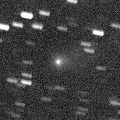
|
Now it is 15.5 mag (June 8, Catalina Sky Survey). It tends to brighten after the perihelion passage. It keeps observable at 16-17 mag from 2012 to 2013. It locates somewhat low in the Northern Hemisphere.
Date(TT) R.A. (2000) Decl. Delta r Elong. m1 Best Time(A, h)
July 28 16 5.84 -18 11.6 2.513 3.118 117 16.9 20:44 ( 19, 35)
Aug. 4 16 7.88 -18 40.0 2.599 3.120 111 16.9 20:35 ( 23, 33)
|

|
It brightened up to 10 mag from autumn to winter in 2011. Now it is appearing in the morning sky again in the Southern Hemisphere. It has already faded down to 16.6 mag (June 30, Jakub Cerny). It keeps observable in good condition while fading graudlaly after this. It will be hardly observable in the Northern Hemisphere.
Date(TT) R.A. (2000) Decl. Delta r Elong. m1 Best Time(A, h)
July 28 4 54.93 -22 8.0 4.430 4.136 66 17.0 3:27 (296, -2)
Aug. 4 4 58.34 -23 46.5 4.410 4.195 71 17.1 3:35 (302, 3)
|
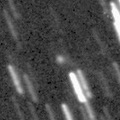
|
Now it is 17.1 mag (June 4, A. Diepvens). It is expected to brighten up to 10 mag from winter to spring in 2013. In the Northern Hemisphere, it keeps observable in good condition until 2013 April. It is not observable now in the Southern Hemisphere. It will become observable after 2013 April, but it keeps locating low.
Date(TT) R.A. (2000) Decl. Delta r Elong. m1 Best Time(A, h)
July 28 1 8.99 80 33.7 3.964 3.820 74 17.3 3:27 (184, 44)
Aug. 4 1 22.09 82 1.0 3.864 3.752 76 17.2 3:35 (183, 43)
|
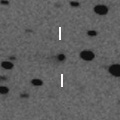
|
Now it is 18.1 mag (June 24, K. Hills). It keeps 17 mag for a long time from 2009 to 2013.
Date(TT) R.A. (2000) Decl. Delta r Elong. m1 Best Time(A, h)
July 28 23 21.15 14 15.9 7.763 8.405 126 17.2 2:58 ( 0, 69)
Aug. 4 23 16.87 14 4.8 7.688 8.418 133 17.2 2:26 ( 0, 69)
|

|
Now it is 17.4 mag (July 24, Siding Spring Survey). It keeps 17.5 mag until September. It is observable in excellent condition in the Southern Hemisphere. But it locates somewhat low in the Northern Hemisphere.
Date(TT) R.A. (2000) Decl. Delta r Elong. m1 Best Time(A, h)
July 28 21 49.84 -34 31.2 0.630 1.613 156 17.6 1:27 ( 0, 20)
Aug. 4 21 45.70 -32 11.0 0.610 1.605 161 17.5 0:56 ( 0, 23)
|
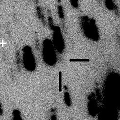
|
First return of a new periodic comet discovered in 1994. Now it is 18.9 mag (July 24, V. Gerke, S. Plaksa, A. Novichonok). It will brighten up to 13.5 mag and will be observable in good condition from autumn to winter.
Date(TT) R.A. (2000) Decl. Delta r Elong. m1 Best Time(A, h)
July 28 19 48.80 31 23.3 1.306 2.096 128 17.9 23:22 ( 0, 86)
Aug. 4 19 41.33 31 59.2 1.249 2.033 127 17.6 22:47 ( 0, 87)
|

|
Now it is 17.9 mag (May 30, K. Hills). It will brighten up to 15.5 mag in 2013 spring. In the Southern Hemisphere, it keeps observable in good condition while the comet will be brightening gradually. In the Northern Hemisphere, it is not observable until 2013 spring.
Date(TT) R.A. (2000) Decl. Delta r Elong. m1 Best Time(A, h)
July 28 17 46.98 -76 11.4 3.735 4.322 119 17.7 21:19 ( 0,-21)
Aug. 4 17 9.82 -74 40.6 3.753 4.283 115 17.7 20:35 ( 1,-20)
|
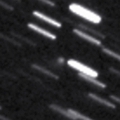
|
Now it is 17.4 mag (June 12, L. Elenin). Now it is brightest. It will be fainter than 18 mag very soon.
Date(TT) R.A. (2000) Decl. Delta r Elong. m1 Best Time(A, h)
July 28 18 3.92 28 58.8 2.436 3.078 120 17.8 21:36 ( 0, 84)
Aug. 4 17 46.69 26 11.7 2.499 3.089 116 17.9 20:52 ( 0, 81)
|
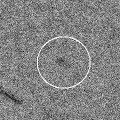
|
First return of a new periodic comet discovered in 2005. Now it is 18.3 mag (July 23, V. Gerke, S. Plaksa, A. Novichonok). It will be observable in excellent condition at 17-18 mag until November.
Date(TT) R.A. (2000) Decl. Delta r Elong. m1 Best Time(A, h)
July 28 23 33.20 3 25.9 1.444 2.234 129 18.0 3:10 ( 0, 58)
Aug. 4 23 33.81 4 8.0 1.381 2.224 135 17.8 2:43 ( 0, 59)
|

|
It was observed at 12.5 mag on Apr. 1, as bright as expected (Michael Jager). However, it has faded very rapidly. Hidetaka Sato reported that it has been already too faint to catch, fainter than 19.0 mag on June 25. In the Northern Hemisphere, it will be high after this. In the Southern Hemisphere, it will never be observable again.
Date(TT) R.A. (2000) Decl. Delta r Elong. m1 Best Time(A, h)
July 28 5 0.57 46 13.6 3.426 2.891 50 19.3 3:27 (233, 32)
Aug. 4 5 11.41 46 31.6 3.433 2.964 54 19.5 3:35 (234, 37)
|
|
![]()
 P/2012 NJ ( La Sagra )
P/2012 NJ ( La Sagra ) C/2012 CH17 ( MOSS )
C/2012 CH17 ( MOSS ) 260P/2012 K2 ( McNaught )
260P/2012 K2 ( McNaught ) 246P/2010 V2 ( NEAT )
246P/2010 V2 ( NEAT ) 78P/Gehrels 2
78P/Gehrels 2 C/2011 O1 ( LINEAR )
C/2011 O1 ( LINEAR ) C/2012 J1 ( Catalina )
C/2012 J1 ( Catalina ) C/2011 A3 ( Gibbs )
C/2011 A3 ( Gibbs ) C/2012 K5 ( LINEAR )
C/2012 K5 ( LINEAR ) C/2011 U3 ( PanSTARRS )
C/2011 U3 ( PanSTARRS ) 189P/NEAT
189P/NEAT 71P/Clark
71P/Clark 168P/Hergenrother
168P/Hergenrother C/2012 L1 ( LINEAR )
C/2012 L1 ( LINEAR ) 152P/Helin-Lawrence
152P/Helin-Lawrence C/2010 G2 ( Hill )
C/2010 G2 ( Hill ) C/2012 L2 ( LINEAR )
C/2012 L2 ( LINEAR ) C/2008 S3 ( Boattini )
C/2008 S3 ( Boattini ) P/2012 O3 ( McNaught )
P/2012 O3 ( McNaught ) 262P/2012 K7 ( McNaught-Russell )
262P/2012 K7 ( McNaught-Russell ) C/2012 K6 ( McNaught )
C/2012 K6 ( McNaught ) C/2012 L3 ( LINEAR )
C/2012 L3 ( LINEAR ) 261P/2012 K4 ( Larson )
261P/2012 K4 ( Larson ) C/2011 Q2 ( McNaught )
C/2011 Q2 ( McNaught )![]()
































